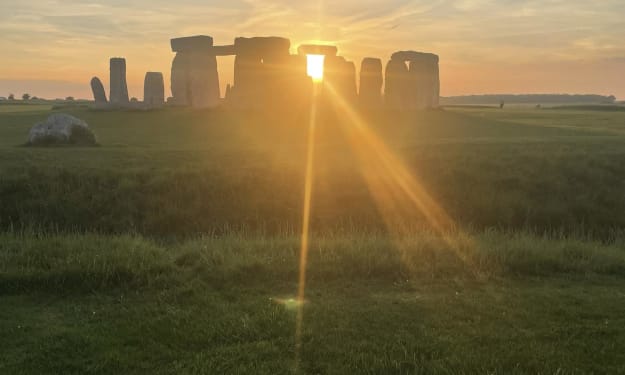The Yoga Of Sound
Pilgrimage to Tamil Nadu

The Yoga Of Sound: Pilgrimage to Tamil Nadu
This was a new type of school. I read that it was supposed to combine spirituality and spiritual practice with social justice. I guess that’s why I wasn’t surprised to find myself far away from home in Oakland CA at the University of Creation Spirituality in a doctoral program doing movement and prayer early in the morning, taking a class on Evil--What it is and Where it Comes From, mid morning, and studying Nada Yoga in the afternoon.
I had heard a lot about evil, but very little about Nada Yoga, the Yoga of Sound. Apparently there is a form of Yoga that has been around for thousands of years that deals with music, chanting, movement, and meditation. The Bhavitic form is a form of worship and devotion singing chants to various gods and goddesses in order to bring one to a state of transcendence and wholeness.
The Vedic Chants were very masculine and powerful. Using the breath and creating sharp sounds would force one to breath correctly, and the way the tongue touched the roof of the mouth would bring about a state of relaxation which would open one to experience the divine. Shakti Yoga was a Tantric Form which did not emphasize transcendence of the human form to attain freedom, but full and complete entry of the Divine into the physical with our bodies as a channel of the holy.
After discussing evil all morning we would go into a dark setting. The windows were covered over with dark plastic. Usually only a few candles were burning. Russill Paul, our teacher, would be sitting there behind an electric piano with a sitar by his side, and a synthesizer, as well as a harmonica. He would get up and explain the three types of Nada Yoga and give instruction. Next he would play all of these instruments at the same time, sounding like a one man band leading us through chants accompanied by presubscribed movements.
Each day we concentrated on a different type of Nada Yoga focusing on the concept of the use of mantra. Mantra was not just saying things, or chanting over and over again, they were specific words strung together in Sanskrit in order to produce specific reactions in the mind and body when repeated several times with the correct breathing and pronunciation.
The whole idea fascinated me to the point where I took many classes with Russill and went to see him at Omega Institute and other venues every so often. He had many CDs out that I bought and listened to repeatedly learning many of the chants on my own. He often talked about a pilgrimage to an Ashram in Southern India that he had each year where we would be totally immersed in the Nada Yoga tradition and the study of mantra. I always wanted to go, but I couldn’t afford it.
Life gets busy. This was a month-long pilgrimage. Usually, if I had enough money to go I didn’t have the time, and when I had the time I didn’t have the money. For many years I thought of it as something out of reach until one year when I was between jobs and had the money.
I decided to go. I felt like I had to take a step in my life and wrap up all of the meditation and studying I had been doing with one push. I had a longing feeling to go deeper and decided that I would fill that feeling and move to a new place, as one job ended and another would begin.
I decided to go and was preparing myself. At the time I was going to a Buddhist Temple and talked about it with friends. One woman there named Brenda heard about it and decided to go too, so we two people from the Temple decided to go. We prepared ourselves.
On that day her husband and children drove up to NY to the airport with us and dropped us off for our departure. I have to admit, it was very exciting. We met other students there heading out to India and took the long flight, not really knowing what to expect. When we arrived at the Airport in India Russill and Asha, his partner, met us there.
It was dark, but still hot around 1 or 2AM. The noises, the sights, the smells, were overwhelming to the senses as we stepped out of the airport pushing our luggage toward a large bus at a rapid pace. It was late, but there were still a lot of people hustling and bustling in the airport. As we got on the bus Asha came up to each of us and hung a necklace of flowers around each of our necks saying they would help keep us cool.
They were a string of marigolds they had kept refrigerated in some way. The feeling of the cool flowers against our necks actually did help to cool us down. Asha said that in India marigolds were used in many celebrations and even as medicine in some cases. It was the flower of India.
And so we headed to the Ashram. It took an overnight train ride, a bus after that, and the tired and bleary eyed we arrived at Sachitananda Ashram in Tamil Nadu. First we chose the small cells that we would be living in while we were there. They were very rustic with a shared bathroom and a couple of showers and one small light and electric that often went off.
It was very primitive, but doable. Next we bought large amounts of bottled water and were told where we could get hand-made clothing suited for the weather and our pilgrimage. We began to settle in, not really worrying about fancy accommodations. We were there for the pilgrimage.
In the afternoon, after getting some rest, we began to do rituals and learn about Hindu and Yogic practices there. Some days we would do workshops there, but as time passed we began to take trips out into the countryside and visit various Hindu Temples to attend their rituals.
Just the grandeur and the age of these temples were overwhelming. It was amazing to just think of all of the work, resources, and labor that went into building them without any modern construction equipment. We would wait to enter the temples.
When we entered we would stand in a line facing the front. It would be hot in many of them. A fire would be burning. The priest would be chanting, many times they would be casting marigolds into the fire as they said each chant, or using them to create a face, or clothing for the form of the god they were celebrating. There was a lot of smoke, banging, chanting, and the use of techniques that were very powerful and moving. These must have been ways of effecting the human psyche that had been studied and perfected for more than 5,000 years.
Afterward we would have dinner in town or return to the Ashram for dinner and debrief if it wasn’t too late. Often, in the streets, many Indians would rush up to Brenda and want to take pictures with her. She was tall with blond hair and blue eyes, which they found fascinating. Many people said she was quite attractive. I have problems with noticing whether a person is attractive or not though.
It is difficult for me to tell if someone is physically attractive because where I was raised, in a very cruel community, the more attractive people were the more cruel they seemed. During that time I learned to look for other qualities. I could see beauty in everyone, but not because of their physical looks, but because of their character and their humanity, the hopes, dreams, likes and dislikes every human being seems to have.
For me to notice that someone is physically beautiful they have to be a real knockout. When that is the case I work to get over my prejudice toward them because of my upbringing and the poor quality of my neighborhood. So it isn’t that I don’t think anyone is beautiful, it is that I think everyone is beautiful.
I think it is similar to all of these marigolds. We saw them everywhere. People were making them into necklaces. They were using them in the Hindu Temples. Some people were making them into tea to help with digestion. Some were eating them in salad.
It is just a small, ordinary looking flower with the petals all clumped together and packed tight...something one could easily ignore, but it can be used as tea. Extract from marigolds can be used to help speed up the healing of wounds, or can be used as eyedrops to help heal eyes damaged by too much ultraviolet light exposure from the sun, and even as ear drops which can clear up ear infections.
This little flower that looks like a dandelion on steroids is simple, pleasant to look at, but powerful. In truth, it reminds me of India. All of these things going on at the same time like petals all packed together look simple, quite normal, but they carry a powerful culture that people from all over the world come to partake of to open their ears and their eyes to reality, and to help heal their wounded souls.
If we in the United States had to choose a flower I guess people would probably choose something simple, like a rose which is dazzlingly beautiful, but I prefer the marigold because it exemplifies the true beauty--the beauty that is much more than skin deep, because it is pleasant, useful, and healing.
About the Creator
Om Prakash John Gilmore
John (Om Prakash) Gilmore, is a Retired Unitarian Universalist Minister, a Licensed Massage Therapist and Reiki Master Teacher, and a student and teacher of Tai-Chi, Qigong, and Nada Yoga. Om Prakash loves reading sci-fi and fantasy.






Comments
There are no comments for this story
Be the first to respond and start the conversation.